Eliza Knight's Blog, page 2
May 6, 2022
How One Famous Socialite Volunteered During WWII
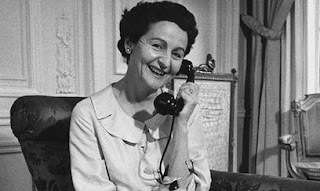
During WWII, novelist Nancy Mitford did quite a lot voluntary service to her country, in addition to working at the famous bookshop, Heywood Hill, where she entertained writers and bibliophiles alike in her makeshift salon, “Club Nancy,” along with sharing the love of books with those left in London.
While two of her sisters were actively courting friendship with Hitler, Nancy doubled down on her patriotic duties to Great Britain. She spent a very short time as an ARP ambulance driver during the Blitz which resulted in a small accident. Considering that there was a blackout at night in London during the blitz, her volunteering to drive was quite brave. All lights were extinguished during this time, and no headlamps were allowed to be used on vehicles, which of course resulted in an increase in accidents.
After the accident, Nancy sought a different type of service. She worked in a first aid post in Picadilly, rolling bandages and assisting those who came in needing aid, but she also used a blue indelible pencil to write identifying information on bodies that came in after the Luftwaffe attacks.
She had a brief stint as a BBC broadcaster, teaching the people of London how to put out fires. However, listeners found her voice to be irritating enough that they wrote into the BBC complaining about it and asking that she be replaced. That didn't stop Nancy from aiding her fellow Brits. She also served on the fire watch herself, often at night after a long shift at Heywood Hill.
When her family’s home, Rutland Gate, was used as a billet for about 70 Jewish refugees from the East End of London, she took up the care and running of the household and its new inhabitants. This included getting everyone's rations, making sure the house was maintained, making appointments for the refugees healthcare, etc...
And, perhaps most intriguing of all, when a friend at the war office asked for her help in spying on the French who’d recently come to London, Nancy didn’t hesitate. She made friends with the Free French officers and got herself invited to their club so she could listen in on their conversations.
The resiliency of those on the home front during WWII has always fascinated me, and I made sure to add Nancy's service to my historical novel, THE MAYFAIR BOOKSHOP, to highlight that she was much more than the scandalous socialite she’s often made out to be. Nancy had a big heart, which was much too often broken.
To dig in further into Nancy's and her family's participation in WWII, including the two sisters who were cozy with Hitler, order the book today!
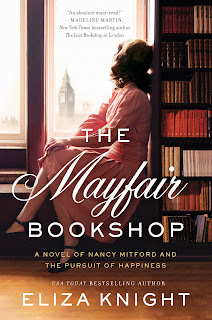
The Mayfair Bookshop: A Novel Of Nancy Mitford And The Pursuit Of Happiness…
From USA Today bestselling author Eliza Knight: a brilliant dual-narrative story about Nancy Mitford—one of 1930s London’s hottest socialites, authors, and a member of the scandalous Mitford Sisters—and a modern American book curator desperate for change, connected through time by a little London bookshop.
1938: She was one of the six sparkling Mitford sisters, known for her stinging quips, stylish dress, and bright green eyes. But Nancy Mitford’s seemingly sparkling life was really one of turmoil: with a perpetually unfaithful and broke husband, two Nazi sympathizer sisters, and her hopes of motherhood dashed forever. With war imminent, Nancy finds respite by taking a job at the Heywood Hill Bookshop in Mayfair, hoping to make ends meet, and discovers a new life.
Present Day: When book curator Lucy St. Clair lands a gig working at Heywood Hill she can’t get on the plane fast enough. Not only can she start the healing process from the loss of her mother, it’s a dream come true to set foot in the legendary store. Doubly exciting: she brings with her a first edition of Nancy’s work, one with a somewhat mysterious inscription from the author. Soon, she discovers her life and Nancy’s are intertwined, and it all comes back to the little London bookshop—a place that changes the lives of two women from different eras in the most surprising ways.
Order your copy!
Personalized Signed Copies: https://www.sykesvillebooks.com/eliza-knight
Harpercollins: https://bit.ly/TheMayfairBookshop
Bookshop: https://bit.ly/TheMayfair_Bookshop
IndieBound: https://bit.ly/TheMayfairBookshop_BuyIndie
Books-a-Million: bit.ly/TheMayfairBookshop_BAM
Amazon Print: https://bit.ly/MayfairBookshop
Amazon Ebook: https://bit.ly/TheMayfairBookshop_Ebook
Amazon Canada: https://bit.ly/MayfairBookshop_CA
Barnes & Noble: https://bit.ly/TheMayfairBookshop_BN
Kobo: https://bit.ly/TheMayfairBookshop_Kobo
Apple: https://apple.co/3AhR8fV
Chapters: https://bit.ly/TheMayfairBookshop_Chapters
Audible: https://bit.ly/TheMayfairBookshop_Listen
February 25, 2022
Cafe de Paris: One of the Hottest Night Clubs of London
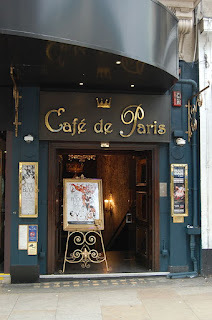
The Cafe de Paris opened in 1924 and was a swanky club in London for food, dancing, music, and drinks for decades. Big bands, famous singers, cabaret dancing, every night was designed with the partying patron in mind.
Headlining the evening's entertainment were some of the biggest stars, like Noel Coward and Marlene Dietrich. Famous American dancer Louise Brooks danced on stage for season. It wasn’t unusual to have a Royal sighting or two since it was a favorite of the princes in the 1920s and 30s--and they may in fact have learned the Charleston while spending a night out on town at the club. Even the young princesses Elizabeth and Margaret made their way to the club, with Prince Philip who was a fan of the hot spot.
Check out this video for a little view inside the club in1929.
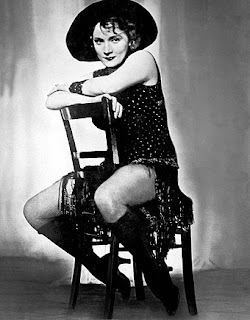

In the 1920s the club was a favorite spot for Fred Astaire and his sister Adele (which you will see in my forthcoming 2023 novel THE OTHER ASTAIRE). Nancy Mitford, one of the Bright Young Things spent plenty of time at the club as well with her friends (which again, you will see in my forthcoming novel THE MAYFAIR BOOKSHOP).
During WWII because the ballroom was below ground people still felt safe living it up when London was under attack (with constant daily bombings they needed to let off steam!) The club management lowered the prices so the club could be enjoyed by more people, including uniformed service members home on leave and needing to blow off steam.


The club remained closed for the duration of the war, opening only after heavy renovations and rebuilding in 1948, as did most of London.
Sadly it closed in late 2020 due to the pandemic and announced they would not be reopening.
February 18, 2022
Nancy Mitford's U and Non-U Idiom
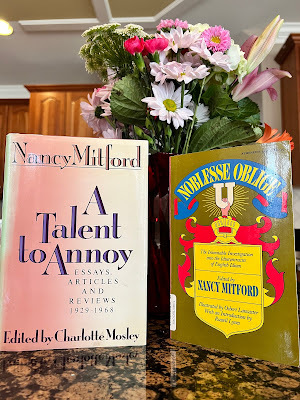 My copies of books that contain Nancy's
My copies of books that contain Nancy's articles on U and Non-U.
Context is everything -- and I'm not just saying that because it is apparently my greatest strength according to a test I just took.
In 1955, Nancy Mitford was asked to write an article about the English aristocracy. She thought it was silly, and was uncertain if she would agree. In fact, she wrote a letter to a family friend, Violet Hammersley, and said:
"Can't quite decide, but if I do it will contain volleys of teases."
Anyone familiar with Nancy knew her wit and witticisms. She was dry, and people didn't often understand her sarcasm. They thought her cruel or snobbish, but I find her fascinating and hilarious.
Nancy did decide to write the article, and she sure did add in a lot of teases.
But, when printed on paper without the benefit of facial expression, or even a small laugh, and especially without being familiar with Nancy on a personal level, a teasing opinion of her own "upperclass" was taken out of context, and in fact caused quite a stir.
One of the elements she included in the article was the U versus Non-U idioms. U stands for Upperclass, and Non-U is Non-Upperclass. In her article she states that she spoke with Professor Ross from Birmingham University, explicitly so that she would not be accused of snobbishness, and that no one would dare accuse a professor. I find this to be rather clever and very "Nancy" of her. But people took all of this incredibly seriously. In fact, they still talk about it today, and they've updated her list for more modern use, AND--no one talks about Professor Ross, even though his list inspired hers.
So what are some examples of U and Non-U?
According to Nancy (and Professor Ross):
Napkin (U) vs Serviette (Non-U)
Bike (U) vs Cycle (Non-U)
Sick (U) vs Ill (Non-U)
Lavatory Paper (U) vs Toilet Paper (Non-U)
House (U) vs Home (Non-U)
In Noblesse Oblige, which Nancy edited, she included her article and then one one written by Professor Ross, which expands on the U vs. Non-U.
Looking glass (U) vs. Mirror (Non-U)
Jam (U) vs Preserves (Non-U)
Rich (U) vs Wealthy (Non-U)
Additionally added to Noblesse Oblige, was her friend Evelyn Waugh's printed response to her English aristocracy article. At the time people saw it as a public rebuke of her, but if you knew how close the two of them were, how very sarcastic they were with each other, then you'd see beyond the actual language to the context beneath which was a teasing reply in itself.
His response opens with:
"Were you surprised that your article on the English aristocracy caused such a to-do? I wasn't. I have long revered you as an agitator--agitatrix, agitateuse?--of genius."
I mean who would read that and think he was serious? Well, I suppose it would be people who didn't know them and those who were already irate about her teasing article to begin with.
The funny thing is, Nancy laughed later that she did use mirror and several other Non-U words in her novels. And I think it's even more funny that to this day, 70+ years later, people are still taking it so seriously.
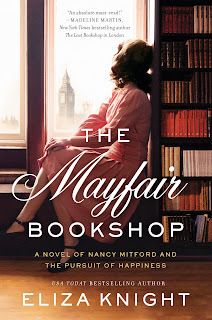
When I was writing my novel, THE MAYFAIR BOOKSHOP, I did a lot of studying of language and "Mitford idiom", because Nancy and her siblings had a singular way of speaking, and I wanted it to come across as authentic in my novel. It wasn't just the U vs. Non-U, they had a lot of words they used that were different than others, some from their own language called Boudledidge, and some just an over-exaggeration of English words like wondair for wonder. They also spoke with a very posh sounding accent that the youngest Deborah remarked on it being irritating even to her sometimes, and that got Nancy removed from a BBC series was hosting. I really enjoyed the deep dive, and I hope you've had some fun reading about the different words.
So, tell me, are you more of a luncheon person or a mid-day dinner? Guess which is U and Non-U!
February 14, 2022
Happy Valentine's Day!
Happy Valentine’s Day!

What *is* this day we celebrate every February 14th with cards, chocolates, flowers and words of love? Believe it or not, this day of love is not something drummed up by modern culture. In fact it’s been around for hundreds of years. There is not one specific Saint Valentine that can be attributed to the holiday as the Catholic Church recognizes three sainted Valentine’s, all martyred. Here is where legends come in to form where the celebration of love was derived on this saint day.
One legend states that in Rome, Emperor Claudius II (3rd century) banned young men from marrying so he could use them as soldiers to fight his wars. A local priest named Valentine rebelled by secretly marrying young couples in love. When his treachery was discovered, he was executed.
Yet, another legend decrees that Valentine while in prison sent the first Valentine’s card himself to a woman who was his beloved, and signed it, “From Your Valentine”.
Why February? Some suggest it is because this is the anniversary of Valentine’s death. Others say that it is because when the Roman’s were trying to convert Pagans to Christianity, they chose a date that coincided with the Lupercalia Festival (a festival celebrated between February 13th and 15th that was meant to chase away evil spirits to release health and fertility.) Judging from how many Christian holidays and saint days fall on or around Pagan celebration days, it would be my guess that the latter was the beginning of it, and the legends created afterward—but that is only my opinion.
It was in the year 498 A.D., Pope Gelasius declared that February 14th was Saint Valentine’s Day.
It is said prior to Chaucer that links to Saint Valentine and February celebrations were mostly about sacrifice and not love. In 1382, Chaucer recorded what is noted as the first indication of Valentine’s Day being romantic. Now, is that to say that there were not previous stories told? No. It just means this is the first piece recorded and used as evidence of an origin date. The problem with history is that we are only as good as the facts we have on hand…
Here is what Chaucer wrote in Parlement of Foules (yr. 1382):
“For this was on seynt Volantynys day Whan euery bryd comyth there to chese his make.”
(Translates as: For this was on Saint Valentine’s Day, when every bird comes there to choose his mate.”)
Perhaps this is where we get the term, “love birds”?
The oldest Valentine’s Day card still in existence today, was written by Charles, Duke of Orleans, in 1415. He wrote the poem for his wife while imprisoned in the Tower of London after the Battle of Agincourt (French and English battle took place in Agincourt, France—English, by what some deem a miracle, won.). The card can be seen at the British Library in London, as part of the manuscript collection. Here is an excerpt:
Je suis desja d'amour tanné Ma tres doulce Valentinée...
(Translates as: I am already sick of love, my very gentle Valentine.)
Shakespeare, in the 16th century, even noted the love-day holiday in his play, Hamlet (Act IV, Scene 5)
To-morrow is Saint Valentine's day, All in the morning betime, And I a maid at your window, To be your Valentine. Then up he rose, and donn'd his clothes, And dupp'd the chamber-door; Let in the maid, that out a maid Never departed more.
In the 17th century Valentine’s Day became even more popular, another chance for not only courtly love to endure, but every one to celebrate love and romance. By the 1700’s pre-made cards became available for purchase. In strict contrast to the romantic period of the 15th and 16th centuries, during the 18th and 19th centuries, expressing ones emotions was frowned upon. Cards that were already made with devotions and admonishments were eagerly grabbed up and given to those who wanted to share romance and love.
In the 1840’s mass-printed Valentine’s Day cards became available in the United States when Esther A. Howland created her beribboned, laced cards.
One of my ALL TIME favorite poems about love was written by Elizabeth Barrett Browning (and one of the reasons I took 18th and 19th century Lit in college), here it is:
How Do I Love Thee? (Sonnet 43)
How Do I Love Thee? Let me count the ways.
I love thee to the depth and breadth and height
My soul can reach, when feeling out of sight
For the ends of Being an ideal Grace.
I love thee to the level of everyday's
Most quiet need, by sun and candlelight.
I love thee freely, as men strive for Right;
I love thee purely, as they turn from Praise.
I love thee with the passion put to use
In my old griefs, and with my childhood's faith.
I love thee with a love I seemed to lose
With my lost saints,- I love thee with the Breath,
Smiles, tears, of all my life!- and, if God choose,
I shall but love thee better after death.
So, for those of you who are skeptics that Valentine’s Day was created to make those in the flower, chocolate, card and jewelry business money, YOU’RE WRONG. While those industries may very well benefit every February, this traditional holiday of expressing one’s romantic feelings dates back hundreds and hundreds of years. For those of you who can’t wait to find the perfect card, or to write the most wondrous poem, I bow to you. Keep the tradition alive and celebrate love to the fullest! But most of all, celebrate that we have the ability to love, and that in this modern age, we can voice it if we want to.
Happy Valentine’s Day! What will you do on this special day?
November 29, 2021
THE MAYFAIR BOOKSHOP Giveaway
My wonderful publisher, William Morrow, is giving away a print copy of The Mayfair Bookshop: A Novel Of Nancy Mitford And The Pursuit Of Happiness…
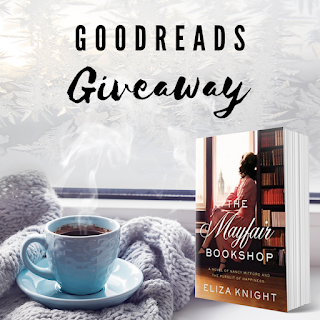
USA Today bestselling author Eliza Knight a brilliant dual-narrative story about Nancy Mitford—one of 1930s London’s hottest socialites, authors, and a member of the scandalous Mitford Sisters—and a modern American desperate for change, connected through time by a little London bookshop.
1938: She was one of the six sparkling Mitford sisters, known for her stinging quips, stylish dress, and bright green eyes. But Nancy Mitford’s seemingly sparkling life was really one of turmoil: with a perpetually unfaithful and broke husband, two Nazi sympathizer sisters, and her hopes of motherhood dashed forever. With war imminent, Nancy finds respite by taking a job at the Heywood Hill Bookshop in Mayfair, hoping to make ends meet, and discovers a new life.
Present Day: When book curator Lucy St. Clair lands a gig working at Heywood Hill she can’t get on the plane fast enough. Not only can she start the healing process from the loss of her mother, it’s a dream come true to set foot in the legendary store. Doubly exciting: she brings with her a first edition of Nancy’s work, one with a somewhat mysterious inscription from the author. Soon, she discovers her life and Nancy’s are intertwined, and it all comes back to the little London bookshop—a place that changes the lives of two women from different eras in the most surprising ways.
The contest ends tomorrow. If you want to enter, click here.
Pre-Order your copy!
Harpercollins: https://bit.ly/TheMayfairBookshop
Bookshop: https://bit.ly/TheMayfair_Bookshop
IndieBound: https://bit.ly/TheMayfairBookshop_BuyIndie
Books-a-Million: bit.ly/TheMayfairBookshop_BAM
Amazon Print: https://bit.ly/MayfairBookshop
Amazon Ebook: https://bit.ly/TheMayfairBookshop_Ebook
Amazon Canada: https://bit.ly/MayfairBookshop_CA
Barnes & Noble: https://bit.ly/TheMayfairBookshop_BN
Kobo: https://bit.ly/TheMayfairBookshop_Kobo
Chapters: https://bit.ly/TheMayfairBookshop_Chapters
Audible: https://bit.ly/TheMayfairBookshop_Listen
Add THE MAYFAIR BOOKSHOP to your reading lists!
Goodreads: https://bit.ly/Read_TheMayfairBookshop
BookBub: https://bit.ly/Share_TheMayfairBookshop
Praise For The Mayfair Bookshop…
"Eliza Knight’s wonderfully descriptive novel is a window into the riveting life of Nancy Mitford, not as an untouchable socialite, but as a woman who has her share of struggles on a very real, very relatable level—an absolute must read!"
— Madeline Martin, New York Times bestselling author of The Last Bookshop in London
"The force of nature that was Nancy Mitford dazzles in The Mayfair Bookshop, first as one of society's 'bright young things' between the World Wars and then as a wildly successful writer. Both Nancy's razor-sharp wit and hidden heartaches make for riveting reading!"
— Stephanie Marie Thornton, USA Today bestselling author of A Most Clever Girl
"Knight brings vividly to life the war years, the troubling associations of Nancy Mitford's aristocratic family, and the ripple effect of their misdeeds throughout England and beyond. A rich portrait of a fascinating woman, The Mayfair Bookshop hits all the right notes: intrigue, great heart, and hope. Not to be missed!"
— Heather Webb, USA Today bestselling author of The Next Ship Home
"Eliza Knight’s The Mayfair Bookshop takes readers into the legendary Nancy Mitford’s head, and more importantly her heart...Twining two timelines together, Knight reminds us that women and books have the power to shape the world, and we have the power to forge our own destinies—even in times of extreme adversity."
— Sophie Perinot, award-winning author of Medici's Daughter
June 7, 2021
Mitford Family Pets
For the past nearly two years, I've had the pleasure of digging even further into the family while researching my forthcoming novel THE MAYFAIR BOOKSHOP.
Side note here, I am SO EXCITED for this book to release, and I will be sharing all of the details here on History Undressed soon, including the cover! The novel is a dual timeline with a modern day book curator who has a connection to Nancy, and then the second point of view is Nancy herself. I've had some really great feedback from early readers!
So back to my topic today...
The Mitfords LOVED their pets. Nancy had a number of dogs, and loved pugs so much, as did most of the family. There are so many fun stories about their pets when they were going up of which they had a veritable menagerie. In the family photo below you can see a couple of cute pets. Nancy is in the top row, sitting down on the left with her dog.
Not shown were the chickens, ponies, goats, etc... Several of Nancy's dogs make appearances in THE MAYFAIR BOOKSHOP. I'm a sucker for dogs, what can I say?
Fun pet fact...Unity Mitford, on the left in the bottom row with two braids (also later in life to be a friend, and rumored mistress to Hitler), also had a pet rat named Ratular, that she would sneak into debutante balls along with her snake Enid to torment the other girls. Nice, right?
I tried to find a picture of her with her rat but alas, I have had no luck. I know I've seen it somewhere, so when I find it, I will update!
Do you have any pets? I have a Newfie, a lab/newf mix, a turtle and a hermit crab <3
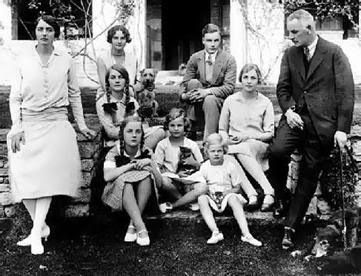
May 25, 2021
The Women of the Jacobite Rebellion and the Prince Charlie's Angels Series
I wanted to incorporate their bravery, tenacity, and enthusiasm for their cause and their loyalty to a prince they wanted to be king, so I used many of their stories when creating those within this series.These women are often lost to history despite having played such a pivotal role during the time. They were spies, messengers, healers, soldiers, smugglers. They helped in whatever way they could to bring the rightful heir--Bonnie Prince Charlie--back to Scotland where he could rule as regent for his father.
Now you may ask, how did you come up with the series title? Obviously, its a play on Charlie's Angels, but Bonnie Prince Charlie had some angels of his own! There is a fun rumor that the Christmas carol “O Come, All Ye Faithful” was in fact a Jacobite call to arms, and that the line “come and behold Him, born the king of angels” was code for “come and behold him, born the king of the English”—who just so happened to be Bonnie Prince Charlie. Allegedly the Latin verse was actually a celebration of the prince’s birth rather than of Jesus’s, all connotation of which was lost when it was translated in the nineteenth century. Learning that his people were nicknamed angels, it seemed a fun theme to incorporate into the series: Prince Charlie’s Angels.
Now, of course, my novels are fiction, so each of my heroines are based on the women rebels, and more than one. I also put a romance swing on each, because after all, I do love a good Scottish romance, and because I believed that each of these women deserved a happily-ever-after.
Below you'll find listed each of my heroines and who I based them on.
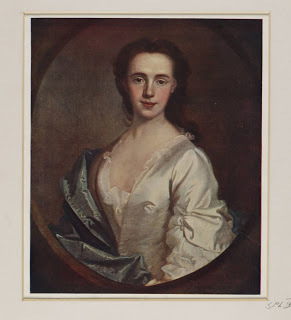 Anne Mackintosh
Anne MackintoshJennyIn The Rebel Wears Plaid, Jenny's story has a flavor of the lives of Lady Anne (Farquharson) Mackintosh, Jenny Cameron and Lady Margaret Ogilvy, who raised troops, collected funds and weapons for the rebels, fought in battles, and aided men in escaping the wrath of their enemies.
Jenny is a rebel soldier herself. She goes against her brother who has sided with the Hanoverian throne, and gives her support to the Stuarts, making a pact with her friends and clan that they will do whatever it takes to see that Bonnie Prince Charlie is returned to his rightful place on the throne. She raises an army, weapons, coin, night after night, and even saves the prince's life. She's not afraid to ride into battle, or thwart the enemy.
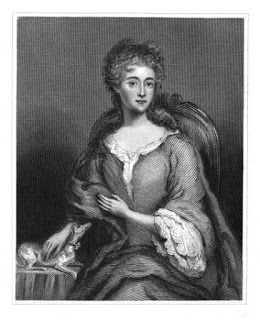 Winifred Maxwell
Winifred MaxwellAnnieIn Truly Madly Plaid, Annie's story is based loosely on Anne MacKay, Anne Leith and Lady Winifred Maxwell, who risked their lives to protect Jacobite soldiers by healing them and aiding in their escape.
Annie has been joining the war camps for some time, mending the men injured in battles and skirmishes. While she can defend herself, she's not a soldier. Her best talents are to heal those who can win the war. On the heals of the Battle of Culloden, her calling pulls her to the battlefield, and she does what she knows best--heals the men she can. And when her bravery is put to the test, she'll face down the enemy, and keep the men she's saved well hidden.
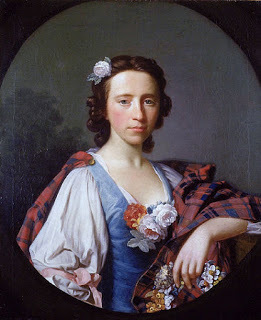 Flora Macdonald
Flora MacdonaldFionaIn You've Got Plaid, you will find Fiona's story to have a flavor of the lives of Flora Macdonald, Barbara Strachan, Anne Leith and the countess unnamed women who risked their lives to deliver messages to their male Jacobite counterparts.
By day, Fiona is a postmistress for the Hanoverian government, which helps her gain insider knowledge that she can then smuggle to her fellow Jacobite rebels. By night, to the rebels, she is known as The Phantom. Fiona is fearless, spending hours, days traveling alone through the Highlands. But then, she is given her most precious package to deliver yet--the prince himself.
Want to read the books? Check them out on my website!
Jenny's story, The Rebel Wears Plaid
Annie's story, Truly Madly Plaid
Fiona's story, You've Got Plaid
March 9, 2021
Kate Quinn's THE ROSE CODE -- Out Today!
I’m so excited about Kate Quinn's fantastic new novel THE ROSE CODE, all about the unsung women codebreakers of Bletchley Park! It's a heart-stopping tale of three friends-turned-enemies who must reunite postwar to crack one last code and root out the spy in their midst.

ABOUT THE BOOK:
1940. As England prepares to fight the Nazis, three very different women answer the call to mysterious country estate Bletchley Park, where the best minds in Britain train to break German military codes. Vivacious debutante Osla is the girl who has everything—beauty, wealth, and the dashing Prince Philip of Greece sending her roses—but she burns to prove herself as more than a society girl, and puts her fluent German to use as a translator of decoded enemy secrets. Imperious self-made Mab, product of east-end London poverty, works the legendary codebreaking machines as she conceals old wounds and looks for a socially advantageous husband. Both Osla and Mab are quick to see the potential in local village spinster Beth, whose shyness conceals a brilliant facility with puzzles, and soon Beth spreads her wings as one of the Park’s few female cryptanalysts. But war, loss, and the impossible pressure of secrecy will tear the three apart.
1947. As the royal wedding of Princess Elizabeth and Prince Philip whips post-war Britain into a fever, three friends-turned-enemies are reunited by a mysterious encrypted letter--the key to which lies buried in the long-ago betrayal that destroyed their friendship and left one of them confined to an asylum. A mysterious traitor has emerged from the shadows of their Bletchley Park past, and now Osla, Mab, and Beth must resurrect their old alliance and crack one last code together. But each petal they remove from the rose code brings danger--and their true enemy--closer...
CHECK OUT THIS INCREDIBLE BOOK TRAILER!
Order your copy today:
Book: https://smarturl.it/RoseCode
Ebook: https://smarturl.it/RoseCodeEB
Audio: https://smarturl.it/RoseCodeAudio
February 14, 2021
Happy Valentine's Day! And a Bit of History

Happy Valentine’s Day!
What *is* this day we celebrate every February 14th with cards, chocolates, flowers and words of love? Believe it or not, this day of love is not something drummed up by modern culture. In fact it’s been around for hundreds of years. There is not one specific Saint Valentine that can be attributed to the holiday as the Catholic Church recognizes three sainted Valentine’s, all martyred. Here is where legends come in to form where the celebration of love was derived on this saint day.
One legend states that in Rome, Emperor Claudius II (3rd century) banned young men from marrying so he could use them as soldiers to fight his wars. A local priest named Valentine rebelled by secretly marrying young couples in love. When his treachery was discovered, he was executed.
Yet, another legend decrees that Valentine while in prison sent the first Valentine’s card himself to a woman who was his beloved, and signed it, “From Your Valentine”.
Why February? Some suggest it is because this is the anniversary of Valentine’s death. Others say that it is because when the Roman’s were trying to convert Pagans to Christianity, they chose a date that coincided with the Lupercalia Festival (a festival celebrated between February 13th and 15th that was meant to chase away evil spirits to release health and fertility.) Judging from how many Christian holidays and saint days fall on or around Pagan celebration days, it would be my guess that the latter was the beginning of it, and the legends created afterward—but that is only my opinion.
It was in the year 498 A.D., Pope Gelasius declared that February 14th was Saint Valentine’s Day.
It is said prior to Chaucer that links to Saint Valentine and February celebrations were mostly about sacrifice and not love. In 1382, Chaucer recorded what is noted as the first indication of Valentine’s Day being romantic. Now, is that to say that there were not previous stories told? No. It just means this is the first piece recorded and used as evidence of an origin date. The problem with history is that we are only as good as the facts we have on hand…
Here is what Chaucer wrote in Parlement of Foules (yr. 1382):
“For this was on seynt Volantynys day Whan euery bryd comyth there to chese his make.”
(Translates as: For this was on Saint Valentine’s Day, when every bird comes there to choose his mate.”)
Perhaps this is where we get the term, “love birds”?
The oldest Valentine’s Day card still in existence today, was written by Charles, Duke of Orleans, in 1415. He wrote the poem for his wife while imprisoned in the Tower of London after the Battle of Agincourt (French and English battle took place in Agincourt, France—English, by what some deem a miracle, won.). The card can be seen at the British Library in London, as part of the manuscript collection. Here is an excerpt:
Je suis desja d'amour tanné Ma tres doulce Valentinée...
(Translates as: I am already sick of love, my very gentle Valentine.)
Shakespeare, in the 16th century, even noted the love-day holiday in his play, Hamlet (Act IV, Scene 5)
To-morrow is Saint Valentine's day, All in the morning betime, And I a maid at your window, To be your Valentine. Then up he rose, and donn'd his clothes, And dupp'd the chamber-door; Let in the maid, that out a maid Never departed more.
In the 17th century Valentine’s Day became even more popular, another chance for not only courtly love to endure, but every one to celebrate love and romance. By the 1700’s pre-made cards became available for purchase. In strict contrast to the romantic period of the 15th and 16th centuries, during the 18th and 19th centuries, expressing ones emotions was frowned upon. Cards that were already made with devotions and admonishments were eagerly grabbed up and given to those who wanted to share romance and love.
In the 1840’s mass-printed Valentine’s Day cards became available in the United States when Esther A. Howland created her beribboned, laced cards.
One of my ALL TIME favorite poems about love was written by Elizabeth Barrett Browning (and one of the reasons I took 18th and 19th century Lit in college), here it is:
How Do I Love Thee? (Sonnet 43)
How Do I Love Thee? Let me count the ways.
I love thee to the depth and breadth and height
My soul can reach, when feeling out of sight
For the ends of Being an ideal Grace.
I love thee to the level of everyday's
Most quiet need, by sun and candlelight.
I love thee freely, as men strive for Right;
I love thee purely, as they turn from Praise.
I love thee with the passion put to use
In my old griefs, and with my childhood's faith.
I love thee with a love I seemed to lose
With my lost saints,- I love thee with the Breath,
Smiles, tears, of all my life!- and, if God choose,
I shall but love thee better after death.
So, for those of you who are skeptics that Valentine’s Day was created to make those in the flower, chocolate, card and jewelry business money, YOU’RE WRONG. While those industries may very well benefit every February, this traditional holiday of expressing one’s romantic feelings dates back hundreds and hundreds of years. For those of you who can’t wait to find the perfect card, or to write the most wondrous poem, I bow to you. Keep the tradition alive and celebrate love to the fullest! But most of all, celebrate that we have the ability to love, and that in this modern age, we can voice it if we want to.
Happy Valentine’s Day! What will you do on this special day?
Do you like podcasts? Check out this podcast I did with my pals, Madeline Martin and Lori Ann Bailey!
November 17, 2020
#TuesdayTeaser for TRULY MADLY PLAID
For now, how about a a little snippet from the prologue?
Icy rain had pelted the earth, threatening to freeze everything into a single slickened crystalized mass, and for now, it had waned at least enough that Lieutenant Craig MacLean felt safe moving out of his tent.
While most of the men were celebrating their victory of the most recent battle, the rest of them were battling the ferocious weather, exhausted and simply looking for a place to get warm.
Craig was of the latter group and trudged toward the house to check on the prince, who’d come down with the ague that had seized a number in his own company. The closer he drew to Bannockburn House, the more certain he was that he could hear someone retching. Dear God, how many more of them were to catch this illness?
Then he saw her, bent almost all the way over, a hand holding her balance on the stone facade of the wall.
Her brow was slick with rain or sweat or both, dark tendrils of hair plastered to her forehead and temples. At his approach she stood up straight, swaying. Her pallor was gray and ghostlike. He stood for a moment watching her, recognizing in an instant who she was. Sister to his friend Graham, Annie MacPherson, the prince’s own healer and a healer to many of the soldiers within camp. Yet it appeared she was the one in need of healing now.
She leaned her back against the stones, stared almost through him, and then turned slowly, pressing her forehead to the cool outer wall. The lass was seriously ill. Craig edged closer.
Och, he’d never seen so much vomit in his life, not even from a drunken soldier. She’d vomited up the entirety of the last meal she’d eaten and perhaps what she’d consumed for the last sennight. Over and over again, so much so he’d begun to think it an unholy thing.
“My lady,” he started, standing only a few feet away now, arm outstretched as though to aid her somehow. She might have been ill as the devil, but he had to help her.
Annie wiped her mouth and then pulled a dagger from her boot, brandishing it toward him with wild eyes. “Get away from me, Sassenach, or I’ll cut off your ballocks and shove them down your throat if ye come another step closer.”


📚WANT MORE?!!?!? Pre-order your copy today!
Truly Madly Plaid
Eliza Knight
📚Add to your reading list!
Goodreads: https://bit.ly/ReadTrulyMadlyPlaid



